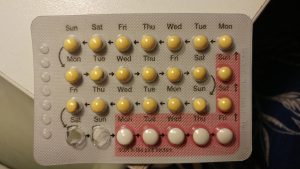Birth-control pills containing the primary female sex hormone, estrogen, have been highly successful in preventing unwanted pregnancies since the 1960s. As these hormone-containing pills started to become both more readily available and socially accepted in recent years, male fish have suffered the consequences of abnormal levels of estrogen in marine environments, turning them into so-called transgender fish. Exposure to increased levels of estrogen in sexually reproducing male fish can cause them to acquire female traits. The loss of male individuals can have detrimental effects on the marine ecosystem as a whole. As a society, we are impacted by these changes due to the fact that over 3 billion people worldwide rely on seafood, including fish, as their primary source of protein. If species of fish are unable to properly reproduce due to the lack of sexually reproducing males, the entire food-web will be disrupted, directly impacting humans, who lie at the top of the web. Not only will society lose a vital food source, but the third-hand intake of estrogen through the consumption of infected fish will undoubtedly have repercussions on the human body.

Estrogen-containing birth control pills. Source: Flickr Credit: Brianna Laugher
Where Does the Estrogen Come From?
When females take birth-control pills, the synthetic estrogen that is consumed will not stay in the human body forever; it will eventually be excreted through the process of urination. Approximately 68 percent of the original dose of birth control is excreted from the human body every time a pill is consumed. In addition, the disposal of unused, unwanted birth-control down sinks and toilets will contaminate waste-water with abnormal levels of estrogen. When this waste-water gets dumped into marine environments, the female sex hormones will also be washed away into lakes and oceans in relatively high doses, inflicting many unwanted consequences on marine organisms.
Feminizing Male Fish

Many male fish are severely impacted by estrogen-contaminated waters. Source: Wikimedia Commons Credit: Firos ak
When male fish are exposed to increased levels of estrogen in their marine habitats, studies have found that they begin to show many feminine traits, rendering them transgender fish. This includes egg production, a decrease in sperm count, and signs of less aggressive behaviour. Certain studies have found that some male fish have even begun to develop ovaries in place of testes when exposed to estrogen. The entire ecosystem can be impacted by this, as a decrease in sexually reproductive male fish can eventually drive an entire species into extinction. A drop in species diversity can lead to serious ramifications, including an increased susceptibility to disease outbreak.
What Can Be Done?

Waste-water treatment plants can remove estrogen from waste-water early on. Source: Flickr Credit: eutrophication&hypoxia
As the primary and most influential contributor of estrogen to waterways is caused by the disposal of hormone-containing waste-water, better waste-water treatment methods can easily be established to prevent this from continuing to occur. Although this simple fix can make a big difference in the reproductive abilities of male fish, the impacts that estrogen has already had on many organisms can nonetheless be passed on to future generations.
Written by Kelsey Wong

2 responses to “Will 2019 Be the Year of the Transgender Fish?”